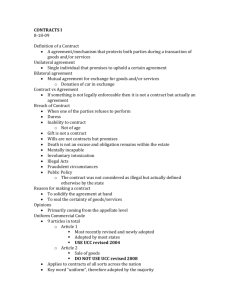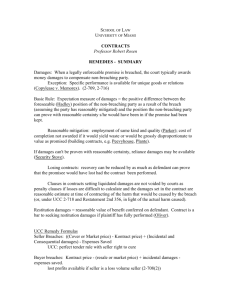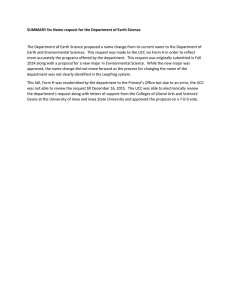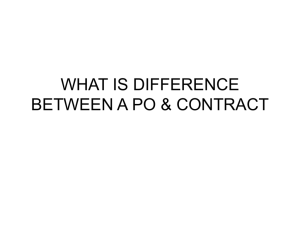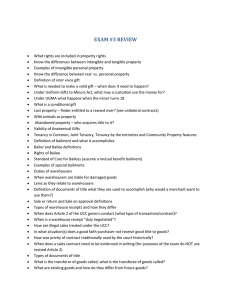Document 15272119
advertisement
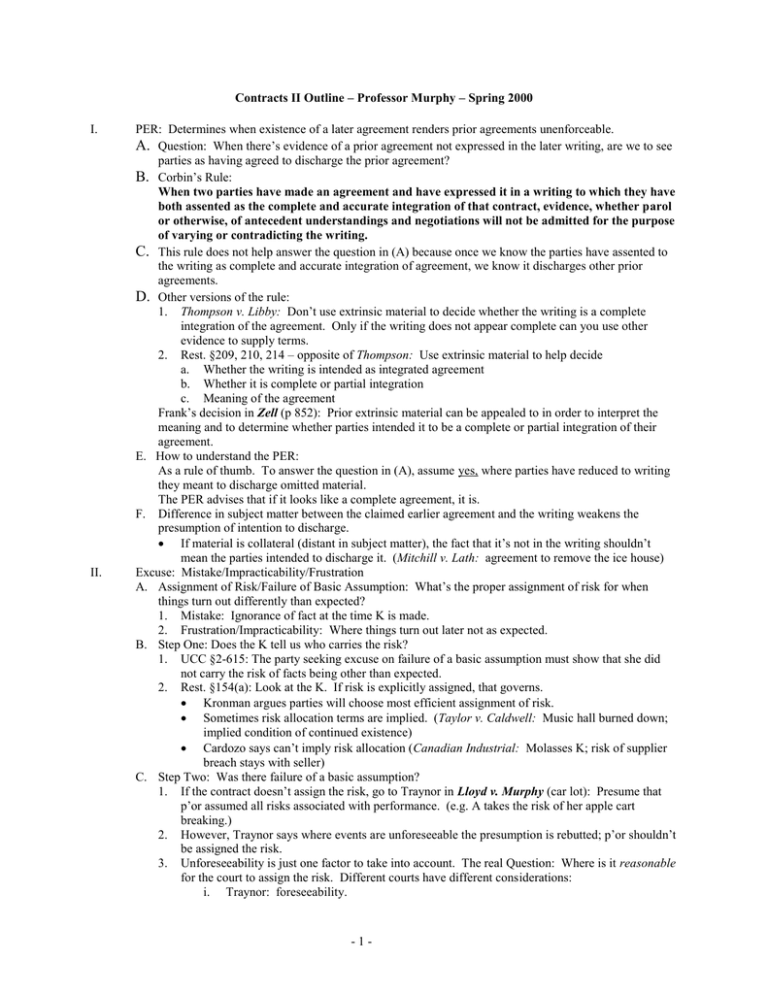
Contracts II Outline – Professor Murphy – Spring 2000 I. II. PER: Determines when existence of a later agreement renders prior agreements unenforceable. A. Question: When there’s evidence of a prior agreement not expressed in the later writing, are we to see parties as having agreed to discharge the prior agreement? B. Corbin’s Rule: When two parties have made an agreement and have expressed it in a writing to which they have both assented as the complete and accurate integration of that contract, evidence, whether parol or otherwise, of antecedent understandings and negotiations will not be admitted for the purpose of varying or contradicting the writing. C. This rule does not help answer the question in (A) because once we know the parties have assented to the writing as complete and accurate integration of agreement, we know it discharges other prior agreements. D. Other versions of the rule: 1. Thompson v. Libby: Don’t use extrinsic material to decide whether the writing is a complete integration of the agreement. Only if the writing does not appear complete can you use other evidence to supply terms. 2. Rest. §209, 210, 214 – opposite of Thompson: Use extrinsic material to help decide a. Whether the writing is intended as integrated agreement b. Whether it is complete or partial integration c. Meaning of the agreement Frank’s decision in Zell (p 852): Prior extrinsic material can be appealed to in order to interpret the meaning and to determine whether parties intended it to be a complete or partial integration of their agreement. E. How to understand the PER: As a rule of thumb. To answer the question in (A), assume yes, where parties have reduced to writing they meant to discharge omitted material. The PER advises that if it looks like a complete agreement, it is. F. Difference in subject matter between the claimed earlier agreement and the writing weakens the presumption of intention to discharge. If material is collateral (distant in subject matter), the fact that it’s not in the writing shouldn’t mean the parties intended to discharge it. (Mitchill v. Lath: agreement to remove the ice house) Excuse: Mistake/Impracticability/Frustration A. Assignment of Risk/Failure of Basic Assumption: What’s the proper assignment of risk for when things turn out differently than expected? 1. Mistake: Ignorance of fact at the time K is made. 2. Frustration/Impracticability: Where things turn out later not as expected. B. Step One: Does the K tell us who carries the risk? 1. UCC §2-615: The party seeking excuse on failure of a basic assumption must show that she did not carry the risk of facts being other than expected. 2. Rest. §154(a): Look at the K. If risk is explicitly assigned, that governs. Kronman argues parties will choose most efficient assignment of risk. Sometimes risk allocation terms are implied. (Taylor v. Caldwell: Music hall burned down; implied condition of continued existence) Cardozo says can’t imply risk allocation (Canadian Industrial: Molasses K; risk of supplier breach stays with seller) C. Step Two: Was there failure of a basic assumption? 1. If the contract doesn’t assign the risk, go to Traynor in Lloyd v. Murphy (car lot): Presume that p’or assumed all risks associated with performance. (e.g. A takes the risk of her apple cart breaking.) 2. However, Traynor says where events are unforeseeable the presumption is rebutted; p’or shouldn’t be assigned the risk. 3. Unforeseeability is just one factor to take into account. The real Question: Where is it reasonable for the court to assign the risk. Different courts have different considerations: i. Traynor: foreseeability. -1- III. ii. Posner: Ex ante efficiency: Who was in best position to avoid the loss? iii. Others: Ex post efficiency: look at equities. D. Step Three: Does the effect of the mistake or change in circumstances warrant an excuse? 1. Mutual Mistake a. Rest. §152-154: These sections separate assignment of risk from failure of basic assumption. This is not done by Rest. §261-265 and UCC. b. How to deal with it: Read §154 – who bears the risk? – use it as an aid to figure out if there’s a §152(1) failure of a basic assumption. (Sherwood v. Walker: pregnant cow thought barren by both; “mistake as to the very nature of the thing”) (Wood v. Boynton: diamond – Mrs. Wood bears risk b/c she failed to ascertain the nature of the stone; note the K may have been voidable but not rescindable b/c no fraud by jeweler.) c. Have to show the adversely affected party suffered material (economic) harm. 2. Unilateral mistake Rest. §153-154: In addition to requirements for mutual mistake: a. Effect of enforcement would be unconscionable or b. Showing that the non-mistaken party had reason to know of the mistake. But: note, the fact that B knew or had reason to know of A’s unilateral mistake will not guarantee excuse for A since A may bear the risk of the mistake. Go to Misrepresentation/Non-disclosure. 3. Impracticability/Frustration a. Increasing liberality: UCC §2-615 synthesizes the doctrines. b. Rest §261, 265 – follows UCC approach but retains the two separate terms (Frustration and Impracticability). c. Need to show that performance became impracticable or substantially frustrated. This speaks to the issue of materiality of mistake. d. This is a harder hurdle than material effect of mistake. Meaning you need more than material effect: Impracticability doesn’t mean party can’t pay damages – School Trustees v. Bennett (Schoolhouse kept falling down due to bad soil.) Frustration: Traynor in Lloyd: Value must be close to zero (selling cars under wartime regulation). Impracticability: American Trading: mere increase in price is not enough (tanker rerouted through Suez Canal) E. What’s the effect of finding mistake, impracticability, or frustration? 1. The adversely affected party may avoid the K, meaning further duties are discharged. 2. Also, he may seek restitution. 3. Beyond that, the remedies story is murky. What about reliance damages that didn’t benefit the other side so can’t be captured under restitution? Rest §158 – restitution + relief as justice requires (mistake) Rest §272 – restitution + relief as justice requires (imprac./frustration) Rest §377 – restitution for part performance (imprac./frustration) UCC §2-614 – lets seller substitute goods; §2-616 lets buyer reject them UCC doesn’t deal w/ recovery of expenses incurred by innocent party. Other Excuses A. Capacity: Rest Ch 2 excuses: under guardianship minors mentally ill intoxicated B. Misrepresentation/Non-disclosure 1. Rest ch 7 topic 1 2. Only difficult issue: Nondisclosure, which sometimes counts as misrepresentation. 3. Rest §161(b) links nondisclosure to unilateral mistake. “…amounts to a failure to act in good faith in accordance with standards of fair dealing…” 4. Rest §161(d) relation of trust and confidence -2- 5. Laidlaw v. Organ (tobacco sale at end of war): No duty to disclose exclusive knowledge of market circumstances 6. Kronman: Encourage information gathering Assign risk to person in best position to get the information (cheapest) Distinguishes casual vs. deliberate knowledge If deliberate, no duty to disclose (encourage cheap info getting) If casual, duty to disclose b/c no cost incurred. Blanket rule: if typically costly/deliberate, then no duty to disclose. 7. If you have misrepresentation under §161, go to a. Rest §162 – Is the misrepresentation fraudulent (made knowingly) or material (likely to induce assent)? If so, go to b. Rest §163 – K is voidable if assent was induced by the misrepresentation and mistaken party was justified in relying on it. C. Duress 1. Rest §175 & §176: There is no blackletter as to what constitutes “use of power for illegitimate ends” [§176(2)(c)] beyond the obvious “your money or your life.” Question: Whether the thing threatened is a crime or a tort. 2. Economic duress: U.S. v. Bethlehem Steel (wartime emergency) 3. In tough cases, duress merges with unconscionability. 4. Difference in remedy: a. Duress: avoidance + restitution. b. Unconscionability: no restitution, see below. D. Unconscionabity: 1. UCC §2-302, echoed in Rest §208 2. Note limited remedial possibilities: No undoing K already performed; no restitution. 3. Exceptional case: Jackson v. Seymor (Sister lets brother manage her affairs, sells farm w/ unknown timber): court resorts to constructive fraud to award add’l damages. 4. UCC §2-302 doesn’t define unconscionability. 5. Some courts find unconscionability on the basis of bad price alone (Jones v. Star Credit, McIver) 6. Williams v. Walker Thomas (furniture paid on installment plan; add-on clause): gives structure to the problem and offers a test. In the absence of true consent, consider the terms of the K in light of the circumstances: Absence of meaningful choice on the part of one party (sometimes b/c of gross inequality of bargaining power) Contract terms unreasonably favorable to the other party (i.e. anything above/below market price) Manner in which the K was entered into Did each party, considering education, have reasonable opportunity to understand terms? General commercial background; “mores and business practices of the time and place” It needs to be unpacked, like we did in class (see handout). 6. Which reasons give grounds for unconscionability finding? Use the lists to structure our thinking, but think for ourselves to come to a judgment on whether a K is unconscionable. A list: Deal is worse than it would be in competitive market: Why? Buyer failed to shop around Structural monopoly – U.S. v. Bethlehem Steel – economic forces at work Situational monopoly – McIver – no other local supplier available Informational disadvantage Market irrationality B list: Deal is not worse than in a competitive market. What’s wrong with it? Informational disadvantage -3- IV. For poor people, market is not appropriate mechanism for distribution of certain goods Decision to buy was imprudent Effects on third parties Market for necessities can be regulated 4. Not as simple as just finding a conflict with a normative aim (e.g. political, social, moral). Need to know more: Will refusal to enforce actually help achieve the relevant normative aim? Steps: (1) assumption that you should enforce. (2) identify a concern which may be sufficient to overcome the assumption. (3) ask, does refusal to enforce promote the aim? (institutional competency) Sometimes even though we’re concerned about (2) it’s not a reason to not enforce. Remember the idea of second best. There may be better ways to achieve goals, but what if they aren’t working (e.g. tax & transfer) Breach A. Which breaches count as failures in condition and therefor discharge other party from obligation to perform? All breaches entitle p’ee to damages. The question about conditions is different. 1. Those breaches expressly noted in the K as conditions. 2. Sufficiently material to count as failure of implied/constructive conditions to justify discharge of other party. 3. Kingston ( to work for and present good security; insufficient security means no deal to transfer business to him). 4. Same rule in Rest §237: failure of condition means other party is excused from performance. B. Failures in Condition 1. What counts as sufficiently material? 2. Courts are concerned about forfeiture: Where A spends in reliance, but because of failure of a condition, B is discharged of further obligations and A loses big. Court will not imply a condition if it results in forfeiture. 3. Courts may even excuse an express condition if it results in disproportionate forfeiture. See Rest §229 4. Alternative approach: Award restitution to the party in breach. Britton v. Turner (breaching employee gets part payment) Rest. §374 5. Special rules for the sale of goods a. UCC §2-601: Perfect Tender Rule: Any departure from description given in K is breach; other party may reject delivery and be excused under §2-602 b. See Miron v. Yonkers Raceway (bought horse, later found broken leg) for example of how to dance around the UCC. (esp §2-601-608) i. §2-607(4) – buyer has burden to show breach wrt goods accepted. ii. Did buyer accept? Under §2-606(1)(b), acceptance occurs: when buyer fails to make effective rejection, but not until buyer has had reasonable opportunity to inspect Under §1-204, reasonableness depends on circumstances. iii. Did buyer make an effective rejection? Under §2-602: rejection must be w/in reasonable time after delivery ineffective unless buyer seasonably notifies seller. Under §1-204, seasonably means w/in agreed time. iv. Where good are effectively rejected, seller has burden of showing they conform to the K. (Comment to §2-602 as interpreted in FN2 of Miron) v. Under §2-608(1), buyer may revoke acceptance of non-conforming good: a. if he reasonably assumed non-conformity would be cured and it hasn’t been seasonably cured, or b. his acceptance was induced by difficulty of discovering non-conformity, or by seller’s assurances vi. May need to consult §2-206 (offer & acceptance) to see if acceptance has occurred. -4- V. C. Anticipatory Breach 1. Restatement §253(1), Roehm v. Horst: When A announces he will breach, B has a cause of action at the time of repudiation (doesn’t have to wait till time performance was due). 2. A’s repudiation releases B from duty to perform -- Rest §253(2). B then has duty to mitigate damages – Clark v. Marsiglia (restore paintings) and Jameson v. Board of Ed (teacher showing up at school) Specific Performance A. An Exceptional Remedy: The general rule is that it’s available only when damages would be inadequate. B. Even when damages appear inadequate there are traditional grounds for refusing to award specific performance. 1. (Most important:) Where K is for personal services – though an injunction requiring a person not to work for people other than may be issued (negative injunction). Lumely v. Wagner (opera singer), Stokes v. Moore (non-competition clause enforced). 2. If court is unable to frame the order with sufficient definitenes 3. Where the order would require a lot of supervision. City Stores – SP awarded for mall building contract C. Whether damages would be adequate depends on the possibility of proving loss with reasonable certainty. VI. Traditional idea: if the subject matter is unique – See UCC §2-716 – i.e. no cover market or equivalent – then it will be hard to prove with sufficient certainty. Otherwise, uniqueness test is about being able to assess damages with sufficient certainty. Money Damages A. Contract Damages are compensatory, not punitive. In the standard case, what you get is expectation damages. B. There are three limitations 1. Avoidability – Rest §350: duty to mitigate damages 2. Certainty – Rest §352 3. Foreseeability – Rest §351(1) and (2): damages recoverable only if p’or had reason to foresee as probable, either b/c arise from breach in ordinary course of events or as result of special circumstances which p’or had reason to know. C. Service Provider Breaches 1. Nonpecuniary Loss If too speculative to be assessed with certainty, can award cost of completing performance p’or didn’t complete. Like the Contract and Market Rule. Standard e.g. is a construction contract. 2. If cost of completion is disproportionate to actual loss to : Difference in market value of ’s property. Rest §348 e.g. Jacob & Young (Reading pipes), Peevyhouse (Mining company doesn’t repair yard). 3. Careful about what completion amounts to. Give sufficient award to bring about same state of affairs as if K were performed. Freund v. Washington Square Press (publishing contract: royalties not awarded due to certainty problem; no SP because of supervision problem). 4. Deduct money already paid under the K. -5- D. Employer Breaches 1. If job is completed, award KP – Rest. §373(2) 2. If partially completed, award reliance costs – Rest. §349 a. If profitable K, add lost profits. Note, profits must be sufficiently certain. b. If losing K, deduct loss saved. i. Unpack expectation damages into (1) costs expended so far and (2) expected profit or loss. ii. can recover for expenses thus far. Albert (recovery for rubber refiner foundations on own property) Behan (cane mats on river bottom is experimental, can’t show profit but can recover expense) iii. However, where can prove would have made a loss on full performance, this amount will be deducted from the damages award. iv. Note, may do better in Restitution. 3. Lost Volume – Like in sale of goods e.g. Neri (sold boat to another buyer) 4. Restitution – about undoing unjust enrichment. For partially performed a losing K, will often do better in restitution because no deduction of provable losses. b. ’s restitution recovery is however offset by the extent to which has conveyed benefits to . c. Under Rest. §371, usually choose method which is more generous to innocent party easier to proove. (i) Reasonable value of benefit received if obtained from someone else (ii) Increase in value of property d. Not available when job is complete – Rest §373(2) e. Kehoe court tried to find middle ground between restitution and expectation damages, but this has been rejected. Kehoe says builder can’t get restitution if > amount earned at K rate Tripple says he can. f. Restitution only available where ’s expenses actually did benefit . Albert – (rubber refinery foundations) restitution was not available Kehoe and Tripple, was available. E. UCC Rules for Sale of Goods Both sellers and buyers can claim difference between actual resale or cover price and the contract price, rather than having to appeal to the market price. The effect is that will only need to appeal to Contract and Market Rule when resale or cover hasn’t been made. Note: UCC §1-106(1) says put in position he’d be in if K were performed. 1. Seller breach a. Was there cover? i. If cover, UCC §2-712 Buyer gets Cover P – KP, subject to reasonableness. If unreasonable delay use Contract and Market Rule (§2-713) ii. If no cover, UCC §2-713 (Contract and Market Rule) Buyer gets Mkt P – KP (use buyer’s location, time of repudiation) Gainsford (bacon seller breaches – cover at time of breach). b. Incidental damages: §2-715(1) c. Consequential damages: §2-715(2) Foreseeable to seller – turns on info available at time of K Hadley v. Baxendale (mill crankshaft) Subject to avoidability; if didn’t try to cover, but could have, no consequential damages. d. Deduct money already paid under the K. a. -6- e. 2. Loss of collateral contract i. Foreseeability: Heron II (foreseeable as a real possibility to or reasonable person) ii. Avoidability: if cover was available but buyer didn’t cover, can’t get consequential damages – Panhandle (K2 damages based on Contract and Market Rule) iii. If it was profitable, lost profit may be recoverable. iv. If it was a loser (below Mkt P), loss saved can’t be deducted because Buyer 2 will sue. v. Buyer 1 can recover buyer 2’s incidental and consequential damages from Seller, subject to certainty. Buyer breach a. Was there resale? i. If resale, UCC §2-706 Seller gets Resale P – KP ii. If no resale, UCC §2-708 Seller gets Mkt P – KP (use time & place for tender) b. Under either 706 or 708, seller gets: Incidental damages Less costs saved. c. Lost Volume – Neri – This is covered under UCC §2-708 -7-
